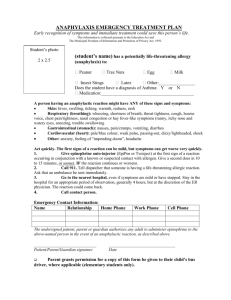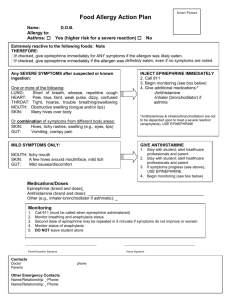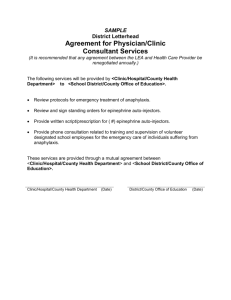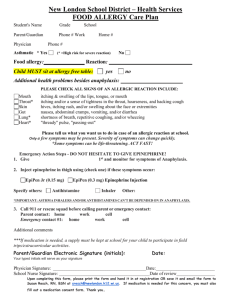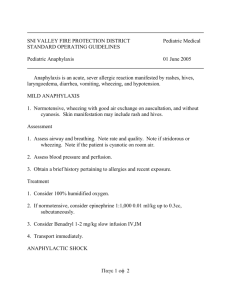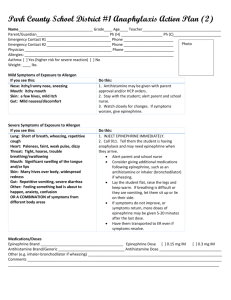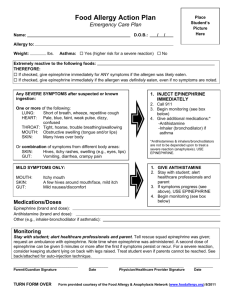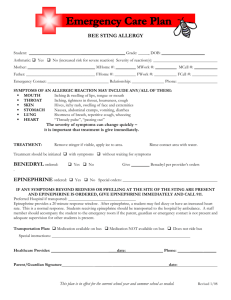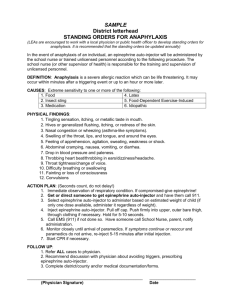Food Allergy, Anaphylaxis & the 911 Lottery
advertisement
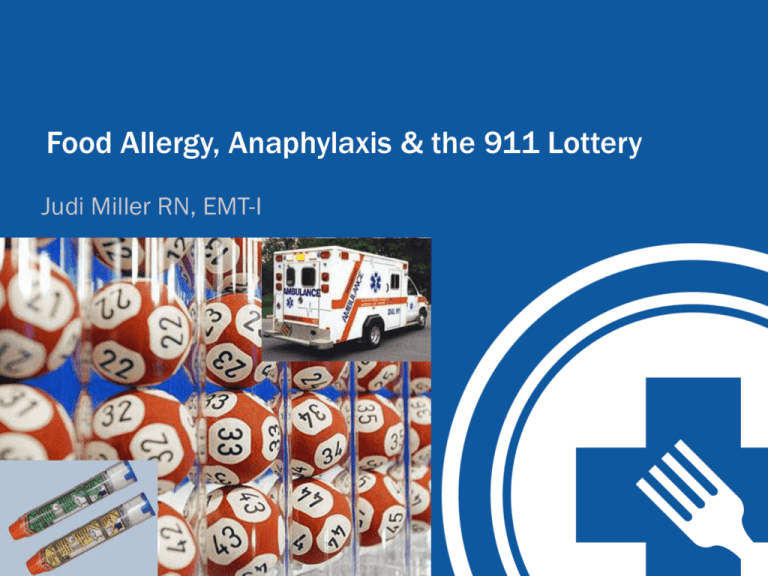
Food Allergy, Anaphylaxis & the 911 Lottery Judi Miller RN, EMT-I Today’s Presenter Judi Miller RN, EMT-I 2 OBJECTIVES Explore the issues of epinephrine availability and administration by EMS providers, including: - legislation - guidance documents - individual state initiatives Results from a recent survey of almost 1,000 pre-hospital caregivers Tips to help you navigate the 911 lottery 3 Picture this… Your child is experiencing symptoms of a severe allergic reaction. You go to grab his epinephrine auto-injector from your purse and it’s not there. After a brief moment of panic, your locate your cell phone instead and call 911. The dispatchers reassure you an ambulance is on its way. 4 Everything’s going to be OK. Right? 5 …it depends! Who responds to the call Where you live Local protocols 6 Who responds to the call EMTs may be divided into several groups based on their level of certification and permitted skills: EMT Basic (EMT-B) EMT Advanced (EMT-A) / EMT Intermediate (EMT-I) EMT Paramedic (EMT-P) 7 Who responds to the call Although 911 calls for anaphylactic shock typically receive an ALS ambulance, BLS crews could be asked to respond to those cases if a distressed caller gives incomplete or inaccurate information to an emergency dispatcher. A BLS ambulance arrives first on scene when an ALS ambulance is further from the scene of the emergency. 8 Who Responds & Provider Knowledge A 2012 survey of US paramedics revealed gaps in knowledge and practice Jacobsen RC, Toy S, Bonham AJ, et al. Anaphylaxis Knowledge Among Paramedics: Results of a national survey. Prehospital Emergency Care 2012;16:527-534 9 Where You Live Wide differences in population density, topography, funding and other conditions have resulted in different types of EMS systems Significant variation between EMS provided from state-to-state...county-to-county…and even agencyto-agency 10 Different EMS systems Fire based EMS systems Non-profit agencies (Rescue squads) Private EMS industry Public service EMS (independent government agency) Hospital based EMS providers Combination systems 11 Different EMS systems U.S. Department of Transportation National Highway Traffic Safety Administration 2008 survey of 7 Mid-Atlantic States 12 Where You Live All 50 states allow paramedics to administer epinephrine 48 states allow EMS personnel to help administer the patient's own epinephrine auto-injector 31 states require that all levels of EMS personnel carry epinephrine auto-injectors or vials 17 states require that EMT-B personnel carry epi 19 states do not require any level of EMS personnel to carry any epinephrine for anaphylaxis Wallace DV, Vitanza JM, Marshall G. The use of epinephrine for the treatment of anaphylaxis in the prehospital setting. ACAAI 2009 13 Where you Live WA NY TX NH MA RI CT NC TN KY MD IL MI WI MN OR http://latexallergyresources.org/epinephrine-policy 14 Where You Live Since 2010 a bill has mandated that all ambulances in New York State, carry epinephrine regardless of the level of provider. “Epinephrine auto-injectors must be on all in-service transporting ambulances. This requirement is for adult and pediatric patients. It may be met by stocking both adult and pediatric epinephrine auto-injectors or through the use of ALS modalities that are already inplace.” 15 Different systems – different protocols EMS providers practice under the license of an EMS Medical Director and deliver care according to local protocols Local protocols override State guidance Providing care that exceeds the scope of the practice outlined in protocols can result in certification being revoked 16 Different systems – different protocols ARLINGTON: ALS only. Severe reaction only FAIRFAX CITY: ALS only. Moderate & Severe reactions FAIRFAX COUNTY: ALS only. Severe reaction only LORD FAIRFAX : BLS & ALS LOUDON : ALS only. Moderate & Severe MANASSAS CITY: BLS & ALS PRINCE WILLIAM: ALS only. Mild, Moderate and Severe 17 From an EMS Perspective… 18 751 Definitions… 19 Epinephrine & BLS Providers 20 21 Naïve Patients 22 Epinephrine use by patients 23 Triggers 24 EMS PHYSICIANS POSITION STATEMENT Epinephrine is the cornerstone of treatment for the potentially life-threatening condition of anaphylaxis There are many reasons why EMS agencies that utilize both BLS and ALS providers should be allowed to carry and administer epinephrine The NAEMSP believes that EMRs should be allowed to both carry and administer EAIs to patients with anaphylaxis Jacobsen RC, Millin MG. The use of epinephrine for out-of-hospital treatment of anaphylaxis. JEMS 2011;127(3):587-93.e1–22 25 Navigating the lottery 26 Educate Yourself Call or visit your local ambulance provider and learn about the EMT- epinephrine policies in your area What type of EMT will respond to a severe allergy / anaphylaxis call? Are all ambulances equipped with epinephrine? What type of EMTs can administer epinephrine, and in what form? What is the average response time? 27 Be Prepared Have an Anaphylaxis Action Plan Avoid allergy triggers Learn how to recognize signs and symptoms Always carry your epinephrine Know when to give it Check expiry dates regularly Give epinephrine before calling 911 When calling 911 request an ALS ambulance Contact your state legislature 28 Questions Thank You 29 Our Next Webinar Managing Food Allergies in the Early Care Setting Wednesday, July 9, 1:00 – 2:00 PM ET Member registration opens Friday, June 6 Open registration begins Monday, June 16 Laurel Francoeur, Esq. AAFA Patient Advocate KFA Education Project Manager Gina Mennett Lee, M.Ed. Food Allergy Consultant, Mennett Lee, LLC Founder, Food Allergy Education Network Director, National Allergy & Anaphylaxis Council 30
